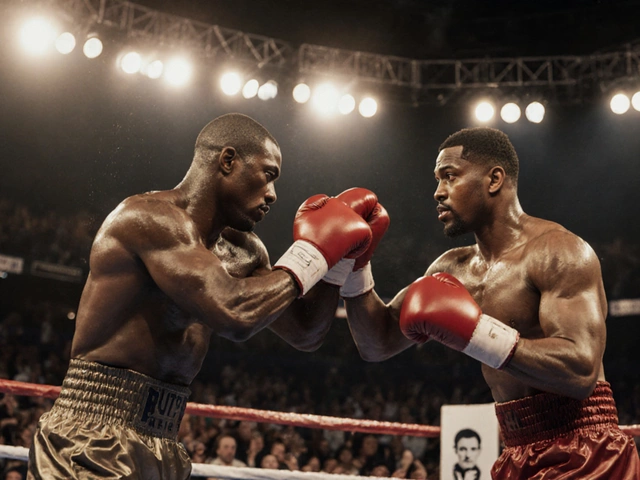Boxing Match Meaning: Simple Guide to the Action in the Ring

Ever wondered what really goes on in a boxing match? It’s not just two people slugging it out to see who hits harder. At its core, a boxing match is a contest with clear rules, rounds, and a huge dose of strategy. Picture two fighters in a square ring, gloves up, trying to outthink and outmaneuver each other for a set number of rounds—usually three minutes each with a short break in between. The goal? Outscore your opponent or knock them down for the count.
There’s way more to a match than just trading punches. Judges track points for each clean hit, defense plays a massive role, and fighters constantly read each other’s moves. Ever noticed how boxers tap their gloves at the start? That's about respect, not war. Matches end when time runs out, someone gets knocked out, or the ref decides it’s too risky to go on. It’s a chess match that happens at full speed.
- The Basics of a Boxing Match
- Rules and How to Win
- What Makes Boxing Matches Unique
- Tips for Watching and Understanding Bouts
The Basics of a Boxing Match
If you’ve ever watched a fight and felt lost, you’re not alone. A boxing match isn’t just about who can punch the hardest or fastest. Everything in the ring has a purpose, down to the last second on the clock.
Let’s start with how matches are set up. Fights take place in a ring that’s usually 16 to 24 feet on each side. That space is carefully measured—no huge floor to run away, no corners to hide in for long. Matches have different lengths depending on the level. For pros, it’s usually 12 rounds, for amateurs, three. Each round is three minutes, with a one-minute breather between them.
| Level | Rounds | Round Duration |
|---|---|---|
| Professional | Up to 12 | 3 minutes |
| Olympic/Amateur | 3 | 3 minutes |
Only certain gear is allowed in the ring. Gloves usually weigh 8 to 10 ounces. For protection, fighters wear mouthguards, cup protectors, and sometimes even padded headgear in amateur bouts. The lighter gloves mean punches feel heavier, and, trust me, they leave a mark.
Before anyone throws a punch, both boxers face medical checks and weigh-ins—no sneaking in above your weight class. There’s a ref in the ring and usually three judges outside. The referee is part coach, part rule enforcer, and part lifeguard, always ready to step in if things get out of hand.
There’s a set list of legal punches (like jabs, crosses, and hooks) and areas you’re allowed to hit. Below the belt, the back of the head, and kidneys? Off-limits. Hit those, and you risk losing points or even getting disqualified. Fighters touch gloves to signal respect before going at it, and that’s more than just a polite gesture. It’s tradition—sort of like shaking hands before a game.
Rules and How to Win
If you’re trying to figure out how a boxing match works, start with the basic rules. Each match is split into rounds—usually 3 minutes for men and women, with 1-minute rests. A pro fight can go up to 12 rounds, while amateur bouts are often 3 or 4. Both fighters wear gloves, mouthguards, and trunks. No kicking, headbutting, or hitting below the belt. Seems obvious, but trust me, refs are super strict about this.
There are a few ways to win in boxing. A knockout (KO) is when you flatten your opponent and they can’t get up before the ref counts to 10. A technical knockout (TKO) happens when the ref decides a fighter is taking too much damage, even if they’re still standing. If nobody knocks anyone out by the final bell, the judges score the fight based on clean punches, defense, ring control, and aggression.
- Knockout (KO): Opponent fails to stand up before a 10-count.
- Technical Knockout (TKO): Referee stops the match to protect a fighter.
- Decision: Judges pick the winner if it goes the distance.
- Disqualification: Fighter breaks major rules (like biting or intentional low blows).
Judging uses the 10-point must system. Each round, the winner gets 10 points, the loser gets 9 or less. If there’s a knockdown, the loser might only get 8. Here’s how a scorecard can look for a 3-round fight:
| Round | Judge 1 | Judge 2 | Judge 3 |
|---|---|---|---|
| 1 | 10-9 | 10-9 | 9-10 |
| 2 | 9-10 | 9-10 | 10-9 |
| 3 | 10-8 | 10-8 | 10-8 |
If a fighter gets knocked down in a round, it usually means they lost that round by an extra point. Simple system, but matches can get controversial if judges don’t see it the same way everyone else does. It keeps things exciting, but also makes for some heated debate in the crowd.

What Makes Boxing Matches Unique
There’s nothing quite like watching a boxing match—no other sport mixes raw action with strict rules and mental games quite the same way. One thing that sets boxing apart? It’s just two people in the ring, face to face. No teammates to cover your back. How you think, move, and react matters every second.
Another big factor is how scoring works. Judges count points for every clean punch that lands, but defense is also rewarded. A boxer who slips, ducks, and avoids hits gets noticed. The stakes are high; one wrong move can turn the tide in a few seconds. This makes every round unpredictable.
"Boxing is about respect. Getting it for yourself, and taking it away from the other guy," — Mike Tyson
Close fights are common, and not every match ends with a knockout. Instead, decisions often go to the judges. Here’s where things get interesting: all it takes is a slightly stronger finish or a few well-timed punches to swing the match. A fighter might lose the early rounds, then storm back in the final minutes.
Check out these quick numbers from the 2023 stats in major bouts:
| Fight Type | % Ending by Decision | % Ending by KO/TKO |
|---|---|---|
| World Title Fights | 62% | 38% |
| Non-title Main Events | 68% | 32% |
Even the crowd makes boxing matches stand out. The energy in the arena or even just in your living room can get wild. People cheer the highs and groan at the close calls. The athletes feed off it—the adrenaline is real.
If you want to dig deeper, look at these unique aspects:
- There are no timeouts. If you’re hurt, you deal with it then and there.
- Each match has a strict weight class. You face someone your size, making it about skill, not just brute strength.
- Fighters often spend months preparing for a single match, tailoring training just to beat their one opponent.
No two bouts are exactly alike, and that keeps fans and fighters hooked fight after fight.
Tips for Watching and Understanding Bouts
If you’re new to boxing, it can look chaotic—the punches fly, the crowd roars, and suddenly someone’s arm is raised in victory. But knowing what to look for sharpens the whole experience. Start by watching the fighters' footwork. A good boxer isn’t flat-footed—they’re always on the move, dodging and weaving to create openings and avoid getting hit.
Pay attention to how often a clean punch actually lands. Judges count every solid hit, not just wild swings. Look for jabs and combos; the jab keeps opponents at bay, while combinations rack up points fast. Defensive moves matter just as much—not just blocking, but slipping and ducking under punches.
Boxing matches are scored round by round, usually using the "10-point must system." The winner of each round gets 10 points, the other usually gets 9, unless there’s a knockdown or a round is very one-sided. Listen for the bell—each round only lasts three minutes, so the action resets quickly. If things seem uneven, the referee can step in, ending a match for a fighter’s safety.
- Notice how fighters control the ring. Ring generalship is when a boxer uses movement to control the pace and place of the action—think of it like claiming turf and making the other guy react.
- Watch the corner between rounds. Coaches give quick advice and patch up cuts. Sometimes these little changes shift the momentum.
- If a match goes to decision, don’t be shocked if judges disagree—it’s common and a huge part of boxing match drama. Split decisions and draws happen, and fans rarely hold back on their opinions.
If you want to learn while watching, put the fight on mute and listen to a pro commentator instead, or look up official scorecards after each round. And here’s my favorite tip: never underestimate the value of defense—some of the best boxers win by simply not getting hit.



